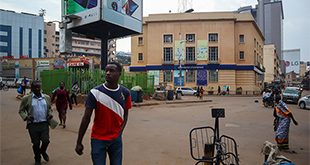
By Haggai Matsiko
Why Museveni’s agenda with America is running out of time
Faradje, a small town of 250,000 people on the edge of the Garamba Forest in north east DR Congo is this December marking the third anniversary since Joseph Kony ransacked it on December 25, 2008 and slaughtered over 900 people.
The fugitive Ugandan rebel leader had just eluded a joint attack by Ugandan and American forces codenamed “Operation Lightning Thunder” on December 14, 2008.
The next year, on December 14, 2009, Kony attacked again. This time he hit Makombo village in Niangara about 300km (Approx. Kampala to Mbarara) killing over 300 people.

Will he strike again this December?
Once again it depends on how a joint attack on Kony by Ugandan and American forces goes.
On Oct. 14, U.S. President Barack Obama announced the deployment of 100 American Special Forces troops to Uganda to aid in “removing Kony”. This is the biggest American deployment in Africa since 2003. By the time Obama made the announcement in a letter to the U.S. Congress, the first team of combat-equipped U.S. soldiers had arrived in Uganda on Oct.12.
Unlike in past operations, however, Obama said some of the American soldiers will be military advisers expected to deploy in the field to the DR Congo, the Central Africa Republic (CAR) and South Sudan.
Army Gen. Carter F. Ham, the head of the U.S. military’s Africa Command, said in an interview with the Washington Post that the troops will stay until Kony is killed or captured.
“If we can help apply pressure — constant pressure — I think we have a reasonable chance of success,” Ham said. “It’s moving in the right direction. Is it going to be successful next week or the week after? Unlikely, unless there’s the proverbial lucky opportunity.”
According to the Post, Ham and other U.S. officials have said they believe Kony and his senior deputies are in the Central African Republic (CAR).
Invisible Children, an NGO campaigning for the end of the Lord’s Resistance Army conflict in Uganda and runs a digital real-time tracker of Kony’s atrocities also reported him to be in CAR and reportedly summoned his commanders to meet there.
It says this year, the largest number of LRA attacks; 50, were six months ago in June. The tracker shows that October was the quietest month. LRA killed 0 civilians and abducted just 3 people in the region.
“This marks the lowest levels of killings and abductions per month seen in the in the last 23 months from its peak at the Makombo Massacre in December 2009,” the Tracker says.
Is this a good sign?
The LRA tracker says Kony’s commanders started heading south to the DRC from CAR in September.
It also shows that all 11 of the attacks reported in October reportedly took place in Haut Uele a vast administrative district in DRC that borders Uganda and is home to the Garamba Forests.

Earlier, between July and September, 32 of the 43 reported attacks occurred here. Most of the attacks were in the Napopo- Benghadi area about 500Kms from the Uganda border. Apart from Benghadi, the only other area to witness numerous LRA attacks over this period is Faradje.
This town is just 100km away from Uganda’s northern border and a new report by the International Crisis Group (ICG) says Kony is once again operating in the area and can easily march to Uganda. It’s a haunting specter that officers of the Uganda army, UPDF, flatly reject.
“Kony is not 500km near Uganda,” says the Uganda Army Spokesman Col. Felix Kulayigye, “If he is in Faradje why hasn’t he returned, doesn’t he know Uganda?”
Col. Phinehas Katirima, a former UPDF spokesman and army representative in Parliament also dismisses the report.
“As you know he is not in Congo as a tourist, he was defeated and fled to take refuge, “he says, “over the last few years, he has not forgotten his way back, he is simply aware that we can finish him in a few days.”
But the UN Office for the Cordination of Humanitarian Aid (OCHA) estimates that in June alone, the LRA made 53 attacks, killed 26 and kidnapped 21 around Bangadi, Ngilima and Faradje.
Before that, from January to May 2011, the LRA made 117 attacks and killed 62 people in the DRC.
Before these attacks which are closer to Uganda, Kony had been operating in faraway Central African Republic (CAR) and inland DRC.
On 24 February 2011 an estimated 50 well-armed LRA fighters attacked Bamangana on the border between Hautand Bas-Uélé Districts, DRC, and burned the Congolese army outpost, killing six of its seventeen soldiers. They took 28 prisoners, but released eighteen later the same day.
On 13-14 March 2011, 20 to 25 LRA attacked a gendarmerie and Central African Republic (CAR) army post at Nzako, Mbomou Prefecture.
Since 2008, the report notes, the LRA has killed more than 2,400 civilians, abducted more than 34,005 and caused an estimated 440,000 to flee their homes in fear.

No political will
Despite the frequent attacks in DRC, CAR, and South Sudan and the lingering threat of fresh attacks on Uganda by Kony, the ICG report indicates that all the regional leaders, including President Museveni, are not acting decisively to finish off the Kony threat.
President Museveni who had sent a 4,500 strong-force to finish Kony in 2009, has since ordered a significant drawdown of troops. At some point, the remaining force consisted of one battalion of about 500 soldiers. This severely reduced Ugandan ability to track, engage, capture or kill LRA fighters, free abductees and protect civilians. Yet Despite this drawback, Museveni’s 500 soldiers remain the biggest force hunting Kony in sometimes hostile territory.
But UPDF military top brass who spoke to The Independent defend the limited deployment.
“We have committed soldiers; we can’t be expected to commit the whole force, to fight who?” Kulayigye asks. He says Kony, at most, has about 400 men.
Kulayigye says people need to understand that the UPDF is not fighting a conventional war, where you know exactly where the enemy is but that this in itself does not mean that UPDF is not interested in finishing LRA.
Kulayigye describes the findings of the ICG report as “false” and “a lazy effort by armchair researchers”.
“Why don’t they question why it took Britain over 100 years to fight IRA; why it took America a decade to find Osama Bin Laden,” he said.
Col. Katirima agrees: “When we were in Congo from 1998 – 2001, we captured airports that were being used by fugitives and wiped him (Kony) out of the safe havens but now hunting him in the thick forests is like looking for a needle in a granary of grass, it is not very easy.”
Politics of war
Apart from the operational military difficulties, capturing or killing Kony and finally ending the three decade long-rebellion that has sucked in four regional states has thrown up myriad political challenges for various leaders involved from President Museveni of Uganda, to Joseph Kabila of DR Congo, Francois Bozize of Central Africa Republic and even Barack Obama of America.
Just weeks after his administration announced that Washington was sending 100 Special Forces, Obama is under pressure to justify American involvement in fighting Kony who, many say, is not a direct threat to the homeland. The pressure is likely to escalate if any U.S. troops are killed in the DRC.
“With his own election looming in a year,” the International Crisis Group report notes, “President Obama is under pressure to prove the deployment can bear fruit quickly. If it does not, it will be called into question.”

The Somalia diversion
Loosely authorised by Congress’s 2009 LRA Disarmament and Northern Uganda Act, the American involvement was boosted by the AU’s formal designation of the LRA as a terrorist organization. However, behind this cloak are other motives including American determination to support their biggest ally in the war against terror in the region, Museveni.
By September 2011 U.S had spent over US$38 million on Uganda’s hunt against LRA, largely in logistics and intelligence support and offered training to the armies of the DRC and CAR. It’s reward for Museveni’s role in dealing with the Al-Shabaab militia in order to protect Somalia’s fragile transitional government and counter the threat of terrorism and Islamist extremism in the Horn of Africa.
Museveni has contributed the main strength of the 6,400-strong force and has pledged to boost Uganda’s 3,400-strong African Union Mission in Somalia (AMISOM) with another 3,000 troops. This, informed sources within the UPDF told The Independent, has stretched the army and incapacitated it from addressing internal threats, including Kony.
Somalia is a priority for Museveni because, according to the ICG, “beefing up Uganda’s contribution to AMISOM presents Museveni with an opportunity to deflect international criticism of his brutal crackdown on a series of opposition protests at home, receive more military aid from Washington and gain political influence in the region.”
Museveni also knows that Ugandan soldiers see more significant earnings by going to Somalia than in the Congo forests.
But if fighting the LRA is not a high priority for Museveni, the report cautions that he needs to ensure Kony does not return to operate in Uganda.
“Kony’s coming to Uganda would deal the government a big blow politically,” says Nicholas Opiyo, an international law expert on the LRA,, “It would be a sign of failure on Museveni’s part whose support has surged because of peace in northern Uganda.”
Already Museveni’s withdrawal of forces has given Kony space and time to recruit more fighters at the same time maintaining his senior fighters and undermined efforts to encourage fighters to defect because there is less military pressure.
“Fewer skirmishes mean fighters and their captives have less reason and fewer opportunities to escape,” the report adds.
Regional hostility
According to the ICG report, troop drawdown, reduced activity and insufficient discipline have contributed to deterioration in relations with locals in all three countries. Civilians, the report notes are frightened and angry that attacks continue while fewer Ugandans do less to protect them.
Uganda’s role in the two Congo wars, including supporting rebels against Kabila’s government and illegally profiting from the country’s natural resources, underlies this mistrust. In 2005 the International Court of Justice ordered Uganda to pay the DRC reparations for violating its sovereignty, but this has not happened.
After Operation Lightning Thunder failed to finish off Kony, Uganda is under pressure to ensure regional support for the current push. Fortunately, the AU has been consulting the four main countries involved countries and donors to strengthen regional efforts. It wants to launch an AU authorized mission, appoint a special envoy for the LRA issue, and set up new military structures to improve coordination between the armies of Uganda and those of the three countries that unwillingly host the LRA.
Barely a month after America’s deployment, the AU meeting in the Ethiopian capital Addis Ababa on Nov. 22 succeeded in designating the notorious rebel outfit, a terrorist group. The AU announcement means it is now forbidden for any state or individual to offer LRA support or allow it to operate on its soil.
Taken together, these are major coups because, according to Opiyo, the rebel outfit has become a mercenary force used by governments in DR Congo, Congo Brazzavile and Northern Sudan as a well-funded mercenary.
“Kabila’s attendance at Museveni’s inauguration for his fourth presidential term on 12 May 2011 and relatively frequent meetings may speak of a cautious willingness to reap the benefits of good neighbourliness, oil money in particular,” the ICG report states, “But having the Ugandan army roving about on Congolese territory, in some places unaccompanied and with no departure date in sight, is beyond the limit of Kabila’s magnanimity.”
According to the report, on the ground, mid-ranking Congolese officers seeking to obstruct the Ugandan operation are in part following the political agenda set by Kinshasa but they could also be expressing their own frustration at having to keep step with the better-trained and equipped Ugandan army, their former enemies, in their own land.
“The Congolese army and local authorities have ratcheted up a smear campaign to turn locals against the Ugandans, whom they accuse of illegally exploiting natural resources, including ivory, gold and bush meat, and attacking civilians,” the report notes.
On two occasions, the DRC has demanded that UPDF leaves its soil. In early 2011, DRC said Ugandan forces must leave by June. This demand was dropped, but on Sept. 30, at a meeting of the army chiefs of staff of Uganda, DRC, CAR, and South Sudan to evaluate operations against the LRA, it again insisted on the withdrawal of all Ugandan troops, except intelligence teams. At that meeting it was estimated that Kony has between 210-240 fighters. However, it was noted that it is difficult to estimate the number of fighters Kony has because they operate in small bands that are highly mobile.
In early October, the Congolese military commander at Dungu, Haut-Uélé District, ordered all Ugandan troops to stop operations and remain on their bases in anticipation of a formal political decision for their departure.
DRC’s mistrust of Uganda has proved infectious, the report adds. In June 2009, Uganda and the CAR signed a formal agreement, and initially Bozizé readily let the Ugandan army into the country to hunt down the LRA, since his own army was incapable.
But in August 2010, he demanded the Ugandans pull out of Sam Ouandja, a village in the north east, fearing they were helping themselves to diamonds there. In September and October 2010, after the Ugandans had left, the LRA attacked several villages in the area.
Col. Kulayigye says that as far as UPDF is concerned, no one has chased them from their territories.
“We have signed agreements with these governments and we have their support,” he says.
Col. Katirima says the countries affected by the LRA are in no position to antagonise Uganda’s efforts to fight a common enemy.
“They have lacked capacity to wipe Kony out,” he says, “as you know they are not fully in charge of their territories.”
Uganda Army Spokesman Col. Kulayigye also says America’s direct involvement is too late. “We are fighting a war that is at its tail end,” he says, “AU and the Americans knew that Kony was a regional problem. We told them this in 2006, it’s now that they have decided to come in; it’s rather too late.”
But Col. Katirima says that since Kony is a regional problem, the joining of Americans is welcome and with logistics Kony will be easy to hunt down. Support for America’s new involvement is obviously not unanimous. If it fails to kill or capture him, then Kony will most likely celebrate with another massacre of hundreds in either Faradje, Makombo, or even Uganda
Important dates
14 October, 2011: U.S. President Barack Obama announces the deployment of 100 Special Forces to assist UPDF put Joseph Kony out of action.
25 November, 2010: U.S. President Barack Obama outlines plans for American intervention in the hunt for Joseph Kony.
16 October, 2010: Uganda, Central African Republic, South Sudan, and DR Congo form a joint brigade to pursue Kony.
24 June, 2010: Enough Project, a Washington-based NGO announces that Kony was almost caught.
14 December, 2009: LRA attack Makombo village in Niangara, DR Congo killing over 300 people in two days.
14 December, 2008: UPDF with rear-U.S. military support launch “Operation Lightning Thunder”; an attack on Joseph Kony’s camps in Garamba Forests in DR Congo. Kony escapes.
25 December, 2008: LRA rebels lauuch a revenge attack on Faradje town and surrounding areas. Up to 900 people are massacred in two days.
Troop Deployment
UPDF: 500
LRA Rebels: 200-400
American Special Forces: 100
 The Independent Uganda: You get the Truth we Pay the Price
The Independent Uganda: You get the Truth we Pay the Price


